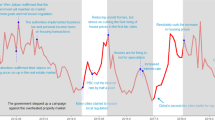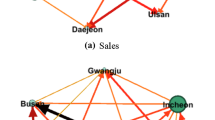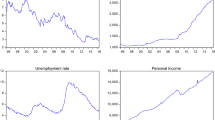Abstract
This paper examines pairwise intercity price–volume dynamics in China using novel daily transaction price and volume dataset from 32 Chinese cities. Despite geographical disparity and time variations, the volume–volume dynamic relationship plays a noticeably more significant role than price–price or price–volume relationships, suggesting that volume may be more informative than prices in China’s pairwise intercity housing market spillovers. We further propose a new spillover/connectedness measure to summarize both price and volume information and better measure such spillovers. We find that the new measure can be significantly explained by economic fundamentals, which attests to the soundness of the basic finding.

Similar content being viewed by others
Notes
Noteworthy, the accounting literature pays much attention to the informational role of trading volume of stocks around earnings announcements. See a review by Bamber et al. (2011).
In the literature, the possible candidates for informativeness of volume or prices on the housing may include the information that can generate more accurate forecast on changes of the housing price (Bollerslev et al. 2016), on the price volatilities (Chinloy and Larson 2017), on the spillover of housing prices (Han et al. 2018; Yang et al. 2018). The specific type of information we examine in this study is related to more accurate (in-sample) forecast on changes of housing prices or volume, most noticably in an intercity spillover context. We thank the referee for making the insightful suggestion.
This is defined by all possible price–volume, price–price, and volume–volume dynamic relationships between a pair of cities, which totals eight, as discussed below. Thus, in addition to its contribution to the literature on the price–volume dynamics, this study also substantially extends the related literature on housing market spillovers. Existing studies on housing market spillovers in China (e.g., Yang et al. 2018) or in other countries generally examine only intercity price-price dynamic relationships in a bivariate or multivariate context, with a noticeable exception of Yang et al. (2021), which, however, examines intercity volume-volume dynamic relationships alone.
Unlike more developed housing markets, both prices and transaction volumes in Chinese housing markets have been to a varying degree explicitly subject to various government intervention policies in China to fight against a speculative mania on these markets. See, e.g., Du and Zhang (2015), Glaeser et al. (2017), and Yang et al. (2021).
The possibility of a leading informational role of housing transaction volume over prices is also being informally recognized in a very few recent studies using international data. For example, although they do not present any empirical evidence, Badarinza and Ramadorai (2018, p. 546) implicitly admits the possibility in their statement that “We view this as encouraging evidence that our method is successful at identifying foreign demand effects that impact volume, and ultimately prices in the London residential real estate market.”.
As our main interest is to shed more light on the informational role of volume versus prices in the pariwise intercity context, the effort nauturally leads to the measurement of pairwise housing market interactions, which nevertheless has the obvious limitations that it is only in the bivariate (rather than multivariate) context and further filtered by certain criteria (i.e., “geographical closeness”). Nevertheless, such a bivariate framework is still used in the recent literature on China’s housing market network (e.g., Hurn et al.,2022). As discussed further below, such limitations may not undercut the inference of the main interest, although they do not offer a complete (multivariate) picture for housing market spillovers, despite its additional use of the information of volume. We leave a more comprehensive multivariate modelling of housing market interactions for future research, as it is beyond the scope of the current paper.
In addition to the nonexisitnce of the official housing price indexes at the daily (or weekly) frequency, the city-level average housing transaction prices in China behaves better than official housing price indexes in accurately relecting the genuin housing price changes, at the comparably monthly frequency. By comparing the self-built housing price index from the mortage data with the Chinese official housing price index and the average transaction prices used in this study, Fang et al. (2016, p. 130) conclude that: “…the average price…exhibits highly synchronized comomoverments with our index……our index is capturing similar fluctuations as the straight calculation of average tansaction prices.”.
Many cities might only report the transaction information in the past few months or never publicly report such information on their official websites.
The longest public holidays in China, like the Spring Festival, are 7 days. But for some smaller cities, there might be up to ten days without housing registrations because of local government’s extended holidays. Thus, if the observations are missing for one month or longer, it can hardly be attributed to public holidays, but instead reflects some irregularities of the concerned housing market.
That is, 100 × (log(current price or volume)-log(previous price or volume)). Thus, they are the logarithm differences of the price or the volume, although we still refer to these as price and volume below.
There is an alternative meaning of asymmetry in the context of Granger causality tests in the literature (e.g., Wang and Ngene 2018), where asymmetry is based on the differences between positive and negative changes in the variables involved.
There are price and volume data even over the weekends. The results are basically the same when the longest lag is set at 14 (2 weeks) or 30 (1 month), because only just a few cities have selected optimal time lags approaching seven.
More specifically, let P1, V1, P2, and V2 denote the housing transaction price and volume of city 1 and city 2, respectively; “P1→P2” denote Granger causality running from prices in city 1 to prices in city 2, and others are defined similarly. The eight possible intercity dynamic relationships thus are P1→P2, P1→V2, V1→P2, V1→V2, P2→P1, P2→V1, V2→P1, and V2→V1.
In the US, only about 6% of owner-occupied homes are traded per year (Piazzesi and Schneider 2009).
To ensure sufficient observations for the examination, again, at least three-month (a quarter) observations exists in a certain year for that city.
The weights are calculated from Tables 3 and 4. The number of significant Granger causalities out of the 73 city pairs is18 for “P1→P2”, 25 for “P1→V2”, 25 for “V1→P2”, 48 for “V1→V2”, 22 for “P2→P1”, 24 for “P2→V1”, 22 for “V2→P1”, and 58 for “V2→V1” (see Tables 3 and 4). Take the first city pair “Anqing—Bengbu” in Table 5 in year 2009 as an example, its ICHTC at year 2009 is thus calculated as \({\mathrm{ICHTC}}_{2009}=\frac{0\times 18+0\times 25+0\times 25+0\times 48+0\times 22+1\times 24+0\times 22+1\times 58}{18+25+25+48+22+24+22+58}\times 100\). We also calculate ICHTC without weights, i.e., \(\mathrm{ICHTC}=\frac{Total number of significant Granger caucalities found in the eight intercity correletions}{8}\times 100\), the estimation results are similar (available on request). Given the finding, it may be easier to use the ICHTC without weights in the future research.
References
Al-Yahyaee KH, Mensi W, Ko H-U, Caporin M, Kang SH (2021) Is the Korean housing ‘market following Gangnam style? Empir Econ 61:2041–2072
Badarinza C, Ramadorai T (2018) Home away from Home? Foreign demand and London house prices. J Financ Econ 130(3):532–555
Bai J (2010) Common breaks in means and variances for panel data. J Econ 157:78–92
Bamber LS, Barron O, Stevens D (2011) Trading volume around earnings announcements and other financial reports: theory, research design, empirical evidence, and directions for future research. Contemp Account Res 28(2):431–471
Berkovec JA, Goodman JL (1996) Turnover as a measure of demand for existing homes. Real Estate Econ 24(4):421–440
Bessembinder H, Chan K, Seguin PJ (1996) An empirical examination of information, differences of opinion, and trading activity. J Financ Econ 40(1):105–134
Billio M, Getmansky M, Lo AW, Pelizzon L (2012) Econometric measures of connectedness and systemic risk in the finance and insurance sectors. J Financ Econ 104(3):535–59
Bollerslev T, Patton AJ, Wang W (2016) Daily house price index: construction modelling and longer-run predictions. J Appl Economet 31:1005–1025
Campbell JY, Giglio S, Pathak P (2011) Forced sales and house prices. Am Econ Rev 101(5):2108–2131
Case KE, Shiller RJ (1989) The efficiency of the market for single-family homes. Am Econ Rev 79(1):125–138
Chen S-S (2012) Revisiting the empirical linkages between stock returns and trading volume. J Bank Finance 36:1781–1788
Chinloy P, Larson WD (2017) The daily microstructure of the housing market. Federal Housing Finance Agency, Working Paper No. 17-01
Clayton J, Miller N, Peng L (2010) Price–volume correlation in the housing market: causality and co-movements. J Real Estate Financ Econ 40(1):14–40
DeFusco A, Nathanson C, Zwick E (2022) Speculative dynamics of prices and volume. J Financ Econ 146(1):205–229
Dröes MI, Francke MK (2018) What causes the positive price-turnover correlation in European housing markets? J Real Estate Financ Econ 57:618–646
Du Z, Zhang L (2015) Home-purchase restriction, property tax and housing price in China: a counterfactual analysis. J Econ 188:558–568
Fang H, Quanlin Gu, Xiong W, Zhou L-A (2016) Demystifying the Chinese housing boom. NBER Macroecon Annu 30(1):105–166
Ferreira F, Gyourko J (2012) Heterogeneity in neighborhood-level price growth in the United States, 1993–2009. Am Econ Rev 102(3):134–140
Genesove D, Mayer C (2001) Loss aversion and seller behavior: evidence from the housing market. Quart J Econ 116(4):1233–1260
Glaeser E, Huang W, Ma Y, Shleifer A (2017) A real estate boom with chinese characteristics. J Econ Perspect 31(1):93–116
Gong Y, Jinxing Hu, Boelhouwer PJ (2016) Spatial interrelations of chinese housing markets: spatial causality, convergence and diffusion. Reg Sci Urban Econ 59:103–117
Granger CWJ (1969) Investigating causal relations by econometric models and cross-spectral methods. Econometrica 37:424–438
Halling M, Moulton P, Panayides M (2013) Volume dynamics and multimarket trading. J Financ Quant Anal 48:489–518
Han B, Han Lu, Zhu G (2018) Housing price and fundamentals in a transition economy: the case of the Beijing market. Int Econ Rev 59(3):1653–1677
Hsiao C (1981) Autoregressive modelling and money-income causality detection. J Monet Econ 7(1):85–106
Hurn S, Shi S, Wang B (2022) Housing networks and driving forces. J Bank Finance 134:106318
IMF (2011) Global economic prospects and policy challenges
Karpoff JM (1987) The relation between price changes and trading volume: a survey. J Financ Quant Anal 22(1):109–126
Keating JW (2000) Macroeconomic modeling with asymmetric vector autoregressions. J Macroecon 22(1):1–28
Leamer EE (2007) Housing Is the business cycle. NBER Working Paper, No. 13428
Leamer EE (2015) Housing really is the business cycle: What survives the lessons of 2008–09? J Money Credit Bank 47(S1):43–50
Leung CKY, Feng D (2005) What drives the property price-trading volume correlation? Evidence from a commercial real estate market. J Real Estate Financ Econ 31:241–255
Leung CKY, Garion L, Youngman L (2002) Testing alternative theories of the property price-trading volume correlation. J Real Estate Res 23:253–264
Leung CKY, Leong YCF, Wong SK (2006) Housing price dispersion: an empirical investigation. J Real Estate Financ Econ 32:357–385
Lo AW, Wang J (2000) Trading volume: definitions, data analysis, and implications of portfolio theory. Rev Financ Stud 13(2):257–300
Miller N, Peng L (2006) Exploring metropolitan housing price volatility. J Real Estate Financ Econ 33(1):5–18
Newey WK, West KD (1987) Hypothesis testing with efficient method of moments estimation. Int Econ Rev 777–787.
Piazzesi M, Schneider M (2009) Momentum traders in the housing market: survey evidence and a search model. Am Econ Rev 99(2):406–411
Piazzesi M, Schneider M, Stroebel J (2015) Segmented housing search. NBER Working Paper, No. 20823.
Roll R, Schwartz E, Subrahmanyam A (2014) Trading activity in the equity market and its contingent claims: an empirical investigation. J Empir Financ 28:13–35
Romano JP, Wolf M (2005) Stepwise multiple testing as formalized data snooping. Econometrica 73:1237–1282
Shi S, Young M, Hargreaves B (2010) House price–volume dynamics: evidence from 12 Cities in New Zealand. J Real Estate Res 32:75–100
Stein JC (1995) Prices and trading volume in the housing market: a model with down-payment effects. Quart J Econ 110(2):379–407
Su ED (2021) Testing stock market contagion properties between large and small stock markets. Rev Quant Financ Acc 57:147–202
Wang J, Ngene G (2018) Symmetric and asymmetric nonlinear causalities between oil prices and the U.S. economic sectors. Rev Quant Financ Acc 51:199–218
Webb RI, Yang J, Zhang J (2016) Price jump risk in the us housing market. J Real Estate Financ Econ 53:29–49
Wheaton WC (1990) Vacancy, search, and prices in a housing market matching model. J Polit Econ 98(6):1270–1293
Xu Z, Meng Q, Wang S (2022) The effect of housing boom on firm leverage evidence from China. Rev Quant Finance Account 58(3):1215–1248
Yang J, Zhou Y (2013) Credit risk spillovers among financial institutions around the global credit crisis: firm-level evidence. Manag Sci 59(10):2343–2359
Yang J, Ziliang Yu, Deng Y (2018) Housing price spillovers in China: a high-dimensional generalized VAR approach. Reg Sci Urban Econ 68:98–114
Yang J, Tong M, Ziliang Yu (2021) Housing market spillovers through the lens of transaction volume: a new spillover index approach. J Empir Financ 64:351–378
Zhang Q, Choudhry T, Kuo J-M, Liu X (2021) Does liquidity drive stock market returns? The role of investor risk aversion. Rev Quant Financ Acc 57:929–958
Zhu B, Füss R, Rottke NB (2013) Spatial linkages in returns and volatilities among U.S. regional housing markets. Real Estate Econ 41(1):29–64
Acknowledgements
We thank the editor and particularly two anonymous referees for extensive comments. An earlier version was presented at the 30th Annual Conference on Pacific Basin Finance, Economics, Accounting, and Management. We acknowledge financial support from the National Natural Science Foundation of China (Nos. 72001119 & 72103105) and the National Social Science Foundations of China (No. 20BJL049).
Author information
Authors and Affiliations
Corresponding author
Additional information
Publisher's Note
Springer Nature remains neutral with regard to jurisdictional claims in published maps and institutional affiliations.
Rights and permissions
Springer Nature or its licensor (e.g. a society or other partner) holds exclusive rights to this article under a publishing agreement with the author(s) or other rightsholder(s); author self-archiving of the accepted manuscript version of this article is solely governed by the terms of such publishing agreement and applicable law.
About this article
Cite this article
Yang, J., Tong, M. & Yu, Z. Can volume be more informative than prices? Evidence from Chinese housing markets. Rev Quant Finan Acc 61, 633–672 (2023). https://doi.org/10.1007/s11156-023-01161-4
Accepted:
Published:
Issue Date:
DOI: https://doi.org/10.1007/s11156-023-01161-4




